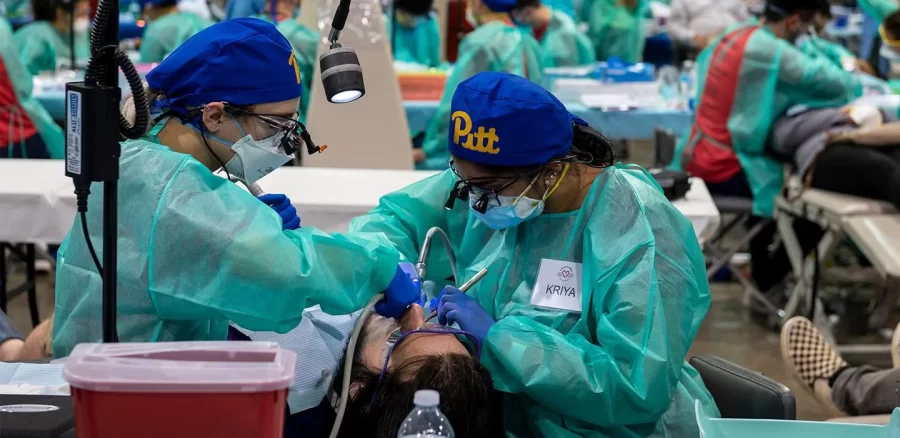Pitt’s dental assistant program addresses healthcare professional shortage
Dental assistant students treat a patient.
November 1, 2022
Dental assistants are in high demand in the region and in the nation, according to Dr. Pamela Tisot. She said dental assistants are integral to the workflow of a successful dental practice.
“Well-trained dental assistants play a critical role in providing patient care,” said Tisot, assistant professor in the Department of Restorative Dentistry and Comprehensive Care in the School of Dental Medicine. “So, I think it is a much-needed benefit to the profession.”
The School of Dental Medicine received funding from the Pennsylvania Department of Labor and Industry to train dental assistants through a 14-month paid apprenticeship program. Six dental assistant students, who have yet to be selected, will start the program in January. According to Kelly Wagner, program director of Pitt Dental Medicine’s Dental Hygiene Program, this program partnered with Pittsburgh Public Schools to address the shortage of healthcare professionals and to increase diversity in the dental workforce.
“We are really trying to focus on the partnership with Pittsburgh Public Schools,” Wagner said. “We really want to build that community with them.”
Applicants to the dental assistant program must be at least 18 years old and have either a high school diploma or GED, according to Wagner. She said the dental school is still conducting interviews and reviewing applications and will have the six dental assistant students selected by the beginning of November.
Jim Earle, executive dean of the dental school, said he and others in the dental school started talking to surrounding public high schools within the past year about sending students to participate in a dental assistant apprenticeship program. Earle said he and others then learned that the Department of Labor and Industry offers grant funding for apprenticeship, which led him and Wagner to write a grant for the funding. Wagner said they received news of the funding sometime in late spring of this year.
While the grant is only intended to fund the program for one year, Earle said he hopes the Department of Labor and Industry will see the success of the dental assistant program and will want to renew the funding for subsequent years to address the shortage of dental assistants.
“There’s such a need for dental assistants right now in the region and in the nation,” Earle said.
According to Wagner, the main role of a dental assistant is to provide chairside assistance to the dentist.
“They help with procedures in dentistry that require four hands, clean and disinfect treatment areas, sterilize instruments, prepare patient operatories, seat patients and update vital signs and medical history,” Wagner said. “Dental assistants are critical in improving efficiency of patient care in the dental office.”
Wagner said she created a rough draft of the dental assistant curriculum, including specific courses and program competencies for the enrolled apprentices. Courses will include topics such as dental radiology and dental materials, according to Wagner.
The dental school is in the process of hiring a faculty member to further develop the dental assistant curriculum, create course content, assess the learning objectives for each course and teach most of the courses the apprentices will take, according to Wagner. She said the dental school has not officially hired this faculty member.
Parts of the dental assistant curriculum will include didactic work, pre-clinical training in simulation dental clinics and chairside work in the actual dental clinics, according to Wagner.
“We really want to get students into the clinical spaces as early as we can,” Wagner said. “There will be a didactic component to the program because a goal of the program is that students are prepared to take their licensure exam by the end of it.”
Tisot said the program will benefit both the dental assistant students and other students in the dental school.
“It will be a benefit to our current dental and hygiene students as well to have the help and opportunity to learn how to work with an assistant,” Tisot said. “It will benefit them in their transition to private practice.”
Wagner said she hopes the program will open the door to students to pursue other pathways in dentistry, such as attending dental hygiene school or dental school.
According to Tisot, the dental assistant program is a great opportunity for students.
“They will receive further education and on-the-job training and graduate from the program with a highly marketable skill,” Tisot said. “They may realize even more potential for advancement that they may not have previously considered.”








